In the evening peak of an evening, thousands of passengers will arrive at the endless subway station. Of course, we can't have all the people like Noah's Ark to carry all the people. In order to solve this problem, we can divert passengers and transfer them to other means of transportation, such as buses and taxis. However, in the end people will still come together again.
On the other hand, energy supply has long relied mainly on fossil energy. The massive development of fossil fuels has caused environmental pollution and a significant increase in the concentration of greenhouse gases in the atmosphere. Coupled with the warming of the global climate in recent years, environmental problems have become more and more serious. Therefore, the national electric energy structure must shift from the traditional coal-based to the multi-energy, especially the emerging renewable energy.
Returning to the example mentioned at the beginning, we can compare passengers to energy, and the increase in passenger flow is like the increasing size of the grid. Therefore, the complexity of the operation and control of the grid is getting higher and higher. We can control these energy packs through semiconductor switches and integrated circuits, allowing energy to operate smoothly, efficiently, and intelligently from input to output. In 2005, Campbell connected the various appliances in the building through a wireless controller and achieved effective control. For example, if an air conditioner is running for 15 minutes and the indoor temperature is maintained at 24 ° C, the other two air conditioners can be shut down for a period of time, thereby improving energy efficiency. This is actually the first seedling of the smart grid.
The traditional power grid is a rigid system. The power supply access and exit, power transmission and other lack of flexibility, resulting in no dynamic flexibility and groupability of the power grid; vertical multi-level control mechanism is slow to respond, unable to build real-time, configurable, reconfigurable System; system self-healing, self-recovery ability depends entirely on entity redundancy; service to customers is simple, information is unidirectional; there are multiple information islands within the system, lack of information sharing
The trend of the times: The interactive grid is the basic model of the next generation of global power grids, and is also the core of China's power grid modernization. It is also an important control bridge for information exchange and communication of the Internet of Things. Then, the new smart grid and energy solutions have the following characteristics.
1. Self-healing grid: The problematic components in the grid are isolated from the system and can be quickly restored to normal operation with little or no human intervention, thus virtually uninterrupted power supply to the user.
2. Human-electric interaction: Encouraging and facilitating user participation in the operation and management of the power system is another important feature of the smart grid. I still remember that in the past, there was a special electrician who went to house to collect electricity. Slowly, everyone can participate in the operation and management of the power grid. In addition, we can open the water heater in the office building before leaving work.
3. Safe and reliable: Various energy sources are integrated into the power grid, which tests its ability to withstand risks.
· Physical attacks or cyber attacks, the smart grid must strengthen the communication of major threat information between power companies and the government.
On the other hand, improving power supply reliability and power quality, especially for war and terrorist attacks.
4. Vigorous and energy-saving: time-sharing, time-sharing, peak-filling, rational use of power resources, energy-saving
· Promote the development of semiconductor intelligent industry, communication systems and equipment manufacturing.
· Promote lower cost solutions and promote the development of new technologies. New clean energy products will also give the market more choices.
Thus, the smart grid is characterized by reliability, self-healing, economy, compatibility, integration and security. The essence of the interactive grid theory is to promote the innovation and upgrading of the power system system, the most important property of the industrial revolution, the establishment of the interaction between consumers and grid managers, and the social economy with the generative standards and technical means of the information revolution. Development has an important role to play:
I. The construction of a strong smart grid will promote the development of smart communities and smart cities and enhance people's quality of life.
II. Promote optimal allocation of energy resources, ensure safe and stable operation of power systems, provide diverse and open power services, and promote the development of strategic emerging industries.
III. The development and utilization of clean energy such as wind energy and solar energy is mainly in the form of producing electric energy. Building a strong smart grid can significantly improve the ability of the grid to access, absorb and adjust clean energy, and vigorously promote the development of clean energy.
With such a meaningful concept of smart grid, how can we paint such a beautiful blueprint?
Second, the solution:First, let's take a short video to learn how to equip the interactive grid, with Texas Instruments' vision for smart grid solutions:
Smart Grid Overview.mp4(ctrl+left mouse button to view, if you can't watch, please open the video in the video folder manually)
That's right, save energy while saving energy, design a smarter grid! Solutions for energy intelligence cover everything from measurement, monitoring, protection, transmission, communications, and microelectronics.
A: Core device:
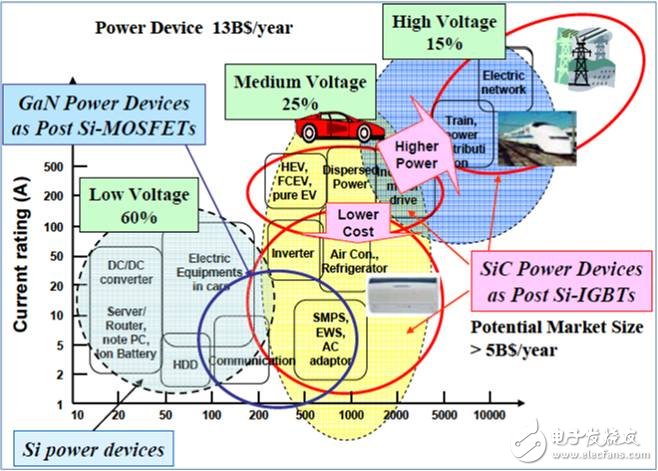
Application of different power semiconductor devices in the field of power
Based on the integration of semiconductor technology and power technology, it enhances the flexibility and reliability of the power grid, and is the advanced control and regulation means of the smart grid.
Traditional mechanical control methods have slow response, infrequent action, and discrete control functions. High-power power electronic devices have stronger, faster, and more effective functions as the core components of the smart grid. This high-power power electronics technology includes High Voltage Direct Current (HVDC), Flexible Alterna TIng Current Transmission System (FACTS), Custom Power (CP), and Voltage Source-based conversion (Voltage Sourced). Converter) Flexible DC Transmission (VSC-HVDC). The use of power devices focuses on its capacity (high current, large voltage), switching frequency, on-state loss, series-parallel use, etc., such as power MOSFETs, IGBTs, GTOs, etc. The third generation of wide bandgap semiconductor materials, SiC and GaN, have brought power electronics to a new level, and people are paying more and more attention to related technical problems.
B: Power Line Communication Technology (PLC):
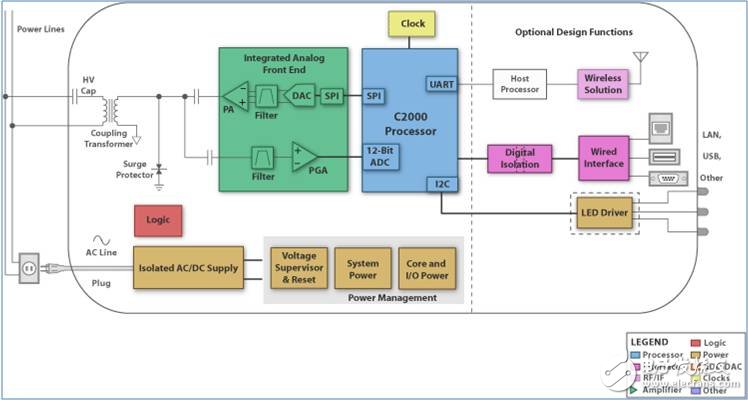
PLC module block diagram
The traditional way of surfing the Internet is no longer described. Now, we have a more convenient and more economical choice: using wires, this is the PLC! The full name of PLC in English is Power Line CommunicaTIon, which is power line communication. By using the power line that transmits current as the communication carrier, the PLC has great convenience. As long as there is no power socket in the room, you can enjoy 4.5~45Mbps high-speed network access without dialing. Phone, and watch online movies, to achieve the "four networks in one" that integrates data, voice, video, and power! PLCs leverage existing powerline infrastructure to provide a cost-effective approach to introducing intelligent monitoring and control in many industrial applications. It makes PLC one of the technology of choice for smart grid applications such as smart meter reading, lighting control, solar, plug-in electric vehicles, and heating, air conditioning and security systems in homes and buildings. The problem is that the power line itself is very noisy, and developing high-efficiency PLC implementations also encounters difficulties such as data reliability.
C: New energy integration:
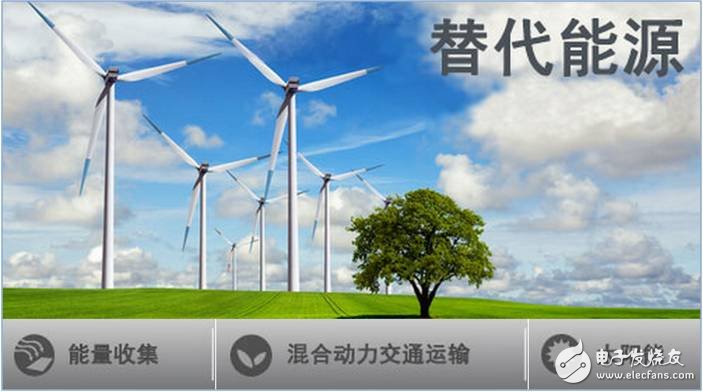
In today's society, energy shortage is a common problem encountered by various countries, and the utilization and transformation of renewable energy and alternative energy are favored by everyone. The feasibility of increasing power density and voltage and efficiency levels is achieved by evaluating solar-to-electrical conversion and new semiconductor materials that meet future needs.
The energy harvesting system includes an energy harvesting module and a processor/transmitter module. The energy harvesting module captures milliwatts of energy from light, vibration, heat, or biological sources. Possible energy sources also come from radio frequencies emitted by cell phone antenna towers. Photovoltaic (PV) installations connected to the grid typically employ an array of modules connected in series to the string inverter. A new system architecture that complements a traditional string inverter with a DC-DC converter dedicated to each module, allowing a single module to collect more energy.
D: Grid infrastructure:
Protection relays are common in all aspects of power grid infrastructure, from power generation to transmission and distribution. They enable operators to monitor and control the grid at different points. The two main functions are measurement and protection. In modern protection relays, communication is also an integral part of the solution, allowing operators to remotely monitor and operate the grid infrastructure. The protection relay input is typically the current and voltage from the line sensor, as well as any communication from other related equipment in the grid network. The output includes a signal (open or closed) sent to the circuit breaker and communication with the grid network. When the protection relay detects a fault, it instructs the circuit breaker to open the line that has detected the fault, thereby providing protection for everything that protects the downstream of the relay. In terms of measurement accuracy and response speed, engineers need more technical support.
E: Electricity meter and monitoring:
Distribution automation and user information collection have always been the weakest link in the development of power systems, and the key to the realization of intelligent power grids. The distribution automation includes the uploading of the collection information of various acquisition control terminals and the release of the control commands of the main station; the collection of user information includes the uploading of the user's electricity usage information and the release of the acquisition instructions. These terminals include data concentrators, intelligent electronic meters, power quality detectors, water meters, heat meters, and the like.
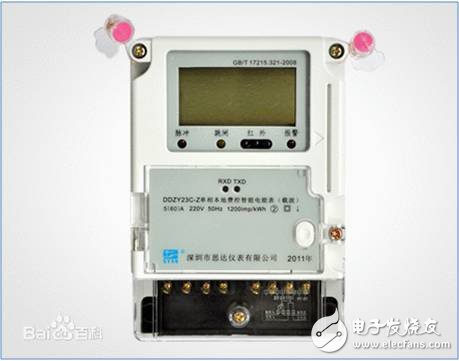
Single-phase local fee-controlled smart meter
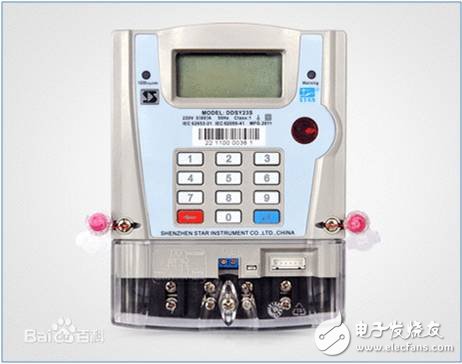
Prepaid smart single-phase code table
For example, the traditional smart meter is used by the user to recharge the smart IC card and input it into the meter. The meter can supply power. When the battery is used up, the power is automatically turned off. The new smart meter is now perfect for network purchase. Recharging your phone is just as easy. In addition to the metering function of the basic power consumption of the traditional electric energy meter, in order to adapt to the use of the smart grid and new energy, it also has electricity information storage, two-way multi-rate metering function, user-side control function, and multiple data transmission modes. Intelligent functions such as two-way data communication function and anti-stealing function, the smart meter represents the development direction of the intelligent terminal of the energy-saving smart grid end user in the future.
Power quality or power protection monitors are commonly used in many industrial environments. Small devices are now also available for home use. They enable operators to monitor both power line disturbances and monitor the power usage of a building, machine or equipment. In some cases, device functions can be remotely monitored and controlled via a modem or high-speed communication line.
Various sensors are responsible for collecting performance and status information for important plant equipment, such as transformers and circuit breakers, and for storing data for future reference. These time-sharing data will be used to perform specific functions and provide decision guidance for operators, maintenance planners, and engineers.
Third, summary:A smart grid is not an end but a process. The construction of smart grid is not only a process of gradually making the grid intelligent, but also a complex system engineering. It needs the support of a series of new technologies and new equipment, and must make breakthroughs in new technology research and new equipment manufacturing. The application of Internet of Things technology and the development of smart cities will bring non-negligible influence to the construction of smart grids, which must be closely followed and in-depth research.
At present, the most representative research on the smart grid standard system in the world is the International Electrotechnical Commission (IEC), the National Institute of Standards and Technology (NIST), and the Institute of Electrical and Electronics Engineers (IEEE). During the "Twelfth Five-Year Plan" period, China will build a "three vertical, three horizontal and one ring network" UHV AC line, and build 11 times of UHV DC transmission project, forming a North China, Central China, East China as the receiving end, to the northwest, northeast power grid In order to send the three synchronous grids, the resource allocation capacity, economic operation efficiency, safety level, technology level and intelligence level of the power grid have been comprehensively improved.
State Grid Corporation has drawn a conceptual model of the technical standards system based on energy flow and information flow:
Integration and planning; intelligent power generation; intelligent power transmission; intelligent power transformation; intelligent power distribution; intelligent power; smart grid dispatch; communication information.
In short, driven by the awareness of green energy conservation, the smart grid has become a key area for competing development in the world. The concept has emerged and emerged as a common choice for the global power industry to meet future challenges. China's electric power workers should adapt to changes in the situation, seize historical opportunities, respond to the call for national energy conservation and emission reduction, and accelerate the pace of informationization and intelligent construction. I firmly believe that the motherland will become the leader of the world's smart grid theory and practice!
Rigid-flex board is a circuit board with FPC characteristics and PCB characteristics formed by combining flexible circuit boards and rigid circuit boards according to relevant process requirements through lamination and other processes.
The rigid-flex board has both the characteristics of FPC and the characteristics of PCB. Therefore, it can be used in some products with special requirements. It has both a certain flexible area and a certain rigid area, which saves the internal space of the product and reduces the The finished product volume is of great help in improving product performance.
Rigid-Flexible Board,Rigid-Flexible Circuit Board,Rigid-Flexible PCB Fabricator,Rigid-Flexible PCB Manufacturer,Rigid-Flexible PCB Supplier
Huizhou Liandajin Electronic Co., Ltd , https://www.ldjpcb.com
